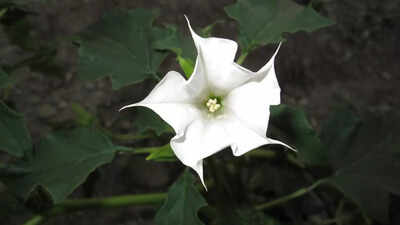Datura: The sacred night-blooming flower you can grow at home by following these 10 steps |

Datura, known as the “moonflower” or “angel’s trumpet,” is a striking and spiritually significant plant native to many parts of India. Its large, trumpet-shaped flowers bloom at dusk, releasing a heady fragrance and offering visual drama to any garden. Deeply rooted in Hindu rituals, especially those honouring Lord Shiva, Datura carries both cultural and ornamental value. Despite its toxicity, it’s easy to grow and care for, making it a popular choice for home gardeners. With the right precautions and growing conditions, Datura thrives in pots or terraces, bringing a mystical charm to urban Indian homes.
Step-by-step guide to growing Datura at home (even in pots or balconies)
Choose the right variety for home gardening
There are several types of Datura, but for home gardeners, especially those growing in pots, Datura metel is a great choice. It’s compact, has highly decorative purple or double blooms, and is widely available in Indian nurseries. This variety performs well in containers and is ideal for small balconies, terraces, or garden beds.
Ensure plenty of sunlight
Datura is a sun-loving plant that needs at least 6–8 hours of direct sunlight each day to thrive. Without sufficient light, the plant may look weak and leggy, and it might not produce flowers. Place your pot in a bright, unobstructed spot—like a south-facing balcony or rooftop.
Use a large, well-draining container
A mature Datura plant can grow quite large, so choose a pot that’s at least 12–16 inches wide and deep. Make sure it has multiple drainage holes. Clay or terracotta pots are ideal because they absorb excess water and prevent the roots from staying too wet—a common cause of root rot.
Prepare the right soil mix
The soil should be well-draining yet nutrient-rich. You can use a mix of:
- 1 part garden soil
- 1 part compost or organic manure
- 1 part cocopeat or coarse sand
This blend ensures good aeration and moisture balance. Avoid using heavy clay soil or pure compost, which can retain too much water.
Start from seeds or cuttings
Datura can be easily grown from seeds. To improve germination:
- Soak the seeds overnight in lukewarm water.
- Sow them 1 cm deep in moist soil.
- Keep the container in a warm, sunny area.
Seedlings typically appear in 1–3 weeks. Alternatively, you can propagate Datura using softwood stem cuttings taken in spring or early summer.
Water mindfully
Datura prefers soil that’s moist but not soggy. Here’s how to water properly:
- During summer, water every 2–3 days or when the top inch of soil feels dry.
- In winter, reduce watering to once a week or less, depending on conditions.
- Always allow excess water to drain out of the pot.
Overwatering can lead to fungal problems and root rot, while underwatering may cause wilting.
Feed monthly during active growth
During the growing season (spring to monsoon), apply a balanced liquid fertiliser once a month. A phosphorus-rich fertiliser will boost flowering. You can also use compost tea or diluted cow dung slurry as a natural option.Stop fertilising during the winter months when the plant goes semi-dormant.
Prune regularly for shape and flowering
To keep your Datura plant bushy and healthy:
- Pinch off the tips when it reaches about 1 to 1.5 feet in height.
- Prune regularly to remove dried leaves and faded flowers.
- Deadheading (removing spent blooms) encourages more flowers to grow.
Pruning also improves air circulation and reduces the risk of pests.
Keep an eye out for pests and fungal issues
Datura is generally resistant to most pests, making it a relatively low-maintenance plant. However, it may occasionally attract common garden pests such as aphids, whiteflies, or spider mites, especially during warm, humid conditions. To prevent infestations, it’s a good idea to spray neem oil every 10–15 days as a natural insecticide. Additionally, wiping the leaves gently with a damp cloth can help remove dust and discourage pests from settling. Avoiding overhead watering is also important, as excess moisture on the leaves can create a favourable environment for fungal growth. With these simple steps, you can keep your Datura healthy and pest-free.
Handle with caution
Datura is highly toxic; its leaves, seeds, and flowers contain compounds that can be harmful if ingested or if sap gets into your eyes or mouth. Always:
- Wear gloves while pruning or repotting.
- Wash your hands thoroughly after handling the plant.
- Keep it out of reach of pets and children.
Despite its toxicity, Datura is safe to grow as long as it’s treated with care and respect, just like any other ornamental plant with strong natural compounds.Datura isn’t just a plant; it’s a living symbol of mystery, transformation, and night-time beauty. Watching it unfurl its creamy or violet flowers at dusk feels almost magical, and its ability to thrive in hot, dry climates makes it perfect for Indian urban gardens.Whether you’re drawn to its spiritual associations or simply want a striking, low-maintenance flowering plant, Datura brings a powerful presence to your garden. With a little sunlight, space, and care, this moonlit beauty will reward you with blooms that turn heads and spark curiosity.Also Read: Why Amaranth is a must-have plant for every home gardener and how to grow it






